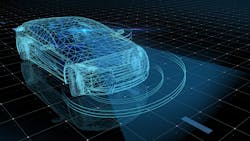The Future of Mobility: A Centralized Vehicle Architecture
This article is part of the Autonomous Vehicles: Technology and Trends series is in the Automotive topic of our Library: Article Series.
What you'll learn:
- Adoption of domain and zonal controllers to help expand functionality.
- Why system consolidation is crucial in future vehicle design.
Today’s automobiles can have more than 100 control units, and this number is set to increase as more connected, autonomous, and electrified capabilities are added in next-generation vehicles. This approach simply isn’t sustainable moving forward. A new networking architecture is needed to meet the demands of advanced vehicles, which includes centralization into larger domain or zonal controllers.
The Evolution of a Centralized Vehicle Architecture
Established vehicle architectures have expanded as functionality grows with each generation. For many advanced vehicles, this has resulted in a large and complex network of electronic control units (ECUs). These architectures have limited flexibility, often making it difficult and costly to enhance functionality. Added to this is the need for in-field updates, higher levels of security, and vehicle-level decision-making that, combined, are rendering the expansion of ECUs unsustainable.
To address this, system developers and carmakers have looked to alternative architectures and started to introduce domain and zonal controllers.
As an industry example, domain controllers are already being adopted, such as those announced by Continental and Volkswagen in their in-car application server (ICAS). These controllers combine features together into a single domain rather than split across multiple ECUs. This consolidation can be used to support functionality more efficiently by simplifying the cable harness, reducing cost and weight, as well as communication time over external buses. It also enables future expansion within field updates to software.
In addition, a zonal controller integrates multiple functions together. However, because functions are determined by their spatial location, this means that multiple, unrelated functions may be combined into a single zone. Often, zonal controllers must support heterogeneous processors for different software stacks from rich operating systems to deterministic real-time control.
There are likely to be fewer controllers in this type of system, each with more functionality integrated within them. Their ability to add functionality based on a common processor architecture helps to simplify the migration of code and it aids with the integration of future functionality.
The Importance of Consolidation for EVs and AVs
Robotaxis are anticipated to be one of the first types of autonomous vehicles (AVs) on the road. One of its enabling technologies is electrification, simplifying how they can remain in service for long periods of time with automated recharging and high levels of reliability. A recent report by Strategy Analytics forecasts that 40% of all cars sold across the globe in 2027 will be electrified.
In the past, dedicated ECUs were used to control a vehicle’s powertrain, but the advent of domain controllers is enabling the integration of entire vehicle propulsion systems. These domain controllers can supervise not only the traction motor, but also battery management and charging as well as chassis functions. Through this centralization, it’s possible to improve overall efficiency by creating a high-level view of the complete system with a single point of management, and in doing so help extend the vehicle’s range.
As with electrified vehicles, AVs are also expected to benefit from centralized architectures. This will allow for new functionality to be added and updated more readily while taking advantage of software-driven features, enabling a software-defined vehicle. Such a consolidated approach to compute supports complex tasks like sensor fusion or path planning, which represent foundational capabilities of future AVs.
Steps to Mobility of the Future
Carmakers have already begun making changes for the introduction of centralized control and new vehicle network architectures. System integrators are now able to create advanced domain controllers enabled by chip manufacturers like STMicroelectronics and NXP. Together, these consolidated domain controllers will continue to help bring the benefits of more efficient vehicle control, as well as the flexibility and scalability to support the evolution of the automobile.
James Scobie is Senior Project Manager at Arm.
Read more from the Autonomous Vehicles: Technology and Trends series is in the Automotive topic of our Library: Article Series.
About the Author
James Scobie
Senior Project Manager, Arm
James Scobie is Senior Project Manager at Arm. With over 20 years of experience in the semiconductor industry, James has a proven track record of innovative embedded microcontroller product definition.
